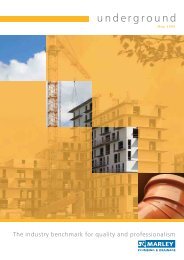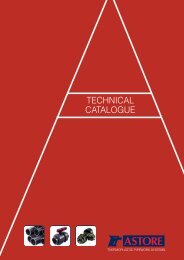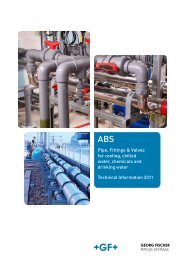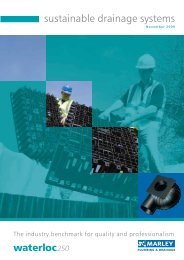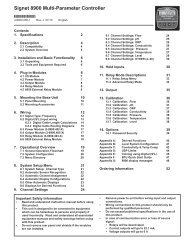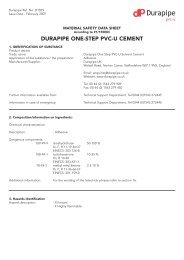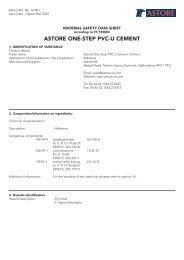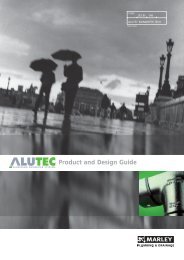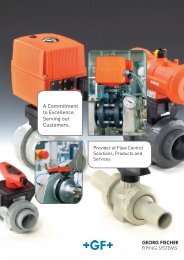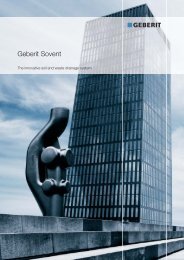SYGEF Product Catalogue
SYGEF Product Catalogue - Building Products Index
SYGEF Product Catalogue - Building Products Index
- No tags were found...
You also want an ePaper? Increase the reach of your titles
YUMPU automatically turns print PDFs into web optimized ePapers that Google loves.
Approximate values for butt fusion of PVDF¹)<br />
Wall<br />
thickness<br />
(mm)<br />
Equalisation<br />
at<br />
p=0.10<br />
N/mm²<br />
Height<br />
of bead<br />
(mm)<br />
Heating<br />
time ²)<br />
p=0.01<br />
N/mm²<br />
(sec)<br />
Changeover<br />
to<br />
Time<br />
time reach<br />
max. full<br />
(sec) jointing<br />
(sec)<br />
Cooling<br />
time ²)<br />
under<br />
jointing<br />
p=0.10<br />
N/mm²<br />
(min)<br />
1.9 .. 3.5 0.5 59 .. 75 3 3 .. 4 5 .. 6<br />
3.5 .. 5.5 0.5 75 .. 95 3 4 .. 5 6 .. 8.5<br />
5.5 .. 10.0 0.5 .. 95 .. 140 4 5 .. 7 8.5 .. 14<br />
1.0<br />
10.0 ..<br />
15.0<br />
1.0 ..<br />
1.3<br />
140 ..<br />
190<br />
4 7 .. 9 14 .. 19<br />
15.0 ..<br />
20.0<br />
20.0 ..<br />
25.0<br />
1.3 ..<br />
1.7<br />
1.7 ..<br />
2.0<br />
190 ..<br />
240<br />
240 ..<br />
290<br />
1) in accordance with DVS 2207-15<br />
5 9 .. 11 19 .. 25<br />
5 11 .. 13 25 .. 32<br />
2) The times are affected by the pipe wall thickness, the<br />
outside temperature and wind strength.<br />
Determine the values to be set for equalisation and<br />
jointing on the basis of the information above, bearing in<br />
mind the instructions from the manufacturer of the fusion<br />
jointing machine before commencing the fusion process.<br />
Fusion jointing procedure<br />
Once it has attained the fusion temperature, position the<br />
heating element in the fusion jointing machine. Press the<br />
parts to be joined against the heating element with the<br />
force required for equalisation until the entire<br />
circumference of each of the jointing faces rests<br />
completely against it and a bead (see the table) has<br />
formed. Reduce the equalisation pressure almost to 0 (p<br />
~ 0.01 N/mm²). The heating time listed in the table is<br />
measured from this moment.<br />
exceed the value listed in the table. Pay particular<br />
attention during jointing that the parts be moved together<br />
swiftly until the surfaces are about to touch.<br />
Then they should be moved together so that they are in<br />
contact along the entire circumference. Next the<br />
pressure should be increased rapidly to the present<br />
jointing pressure within the period of time specified in the<br />
table. This pressure must be maintained during the entire<br />
cooling period. Adjustment may be necessary, especially<br />
shortly after the jointing pressure has been attained.<br />
The jointed parts must stay in the fusion jointing machine<br />
under jointing pressure until the end of the cooling period<br />
specified in the table.<br />
Join and cool<br />
Leave parts in the fusion jointing machine at fusion<br />
pressure until the end of the cooling period!<br />
Once the heating period has elapsed, remove the parts<br />
from the heating element which should then be removed<br />
without touching the jointing surfaces and push the parts<br />
together immediately. The changeover time must not<br />
Fusion check<br />
A bead should form around the entire circumference of<br />
the pipe. K in the diagram to the left should always be<br />
positive.<br />
Carrying out the pressure test<br />
All fusion joints must be allowed to cool completely<br />
before pressure testing, i. e. as a rule wait about 1 hour<br />
after the last joint has been completed.<br />
23



